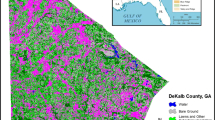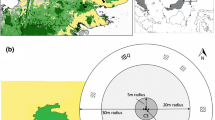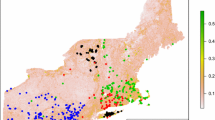Abstract
The interaction between plant attributes, environmental factors and the history of human intervention determines which species show a more invasive behavior and which areas are more likely to be invaded. Identifying which factors favor the invasion and which constraint it, remains an essential goal for understanding the process of invasion and to provide a stronger scientific basis for designing management actions to reduce susceptibility to invasion. In this paper we analyze the relative role of different environmental factors in plant invasion, in particular the comparison between human versus climatic and biotic variables at different spatial scales. Furthermore, we show how these factors interact to influence the distribution and abundance of an invasive plant. We have built mixed models to explain the presence and abundance of a renowned invasive species in the south-central area of Chile, Teline monspessulana (French broom, Fabaceae). We recorded the presence and cover of this invasive shrub in a series of transects along the main roads of the study area. For each transect we recorded variables at different spatial scales related to climate and land use. We found that the presence and cover of T. monspessulana are strongly related to proximity to roads, urban areas and locations with higher rainfall. Although this shrub is present in most of the landscape, it is most abundant in shrublands and forest plantations. In a complex human-dominated landscape matrix, shrublands and forest plantations act as a source of propagules from which new areas can be invaded. Interestingly, the presence of this species can be better predicted by combining predictors taken at two hierarchical levels, the so-called transect and plot scales, whereas the species abundance only depends on factors at the plot level. The presence and abundance of this species is highly dependent on human disturbance, and the occurrence of certain landscape elements closely linked to land management is critical to the performance of this species. Maintaining a dense tree canopy cover and reducing the use of fire could help reduce the rate of expansion of this species across the landscape.


Similar content being viewed by others
References
Adams R, Simmons D (1991) The invasive potential of Genista monspessulana (Montpellier broom) in dry sclerophyll forest in Victoria. Vic Nat 108:84–89
Aguayo M, Pauchard A, Azocar G, Parra O (2009) Cambio del uso del suelo en el centro sur de Chile a fines del siglo XX. Entendiendo la dinámica espacial y temporal del paisaje. Rev Chil Hist Nat 82:361–374
Alexander J, D’Antonio C (2003a) Control methods the removal of French and Scotch Broom tested in coastal California. Ecol Rest 21:191–198
Alexander J, D’Antonio C (2003b) Seed bank dynamics of French broom in coastal California grasslands: effects of stand age and prescribed burning on control and restoration. Restor Ecol 11:185–197
Alpert P, Bone E, Holzapfel C (2000) Invasiveness, invasibility and the role of environmental stress in the spread of non-native plants. Perspect Plant Ecol Evol Syst 3:52–66
Baesa MJ, Roy J (2008) Germination of an obligate seeder (Ulex parviflorus) and consequences for wildlife management. Forest Ecol Manag 256:685–693
Bossard C (2000) Genista monspessulana (L.) L. Johnson. In: Bossard CC, Randall JM, Hoshovsky MC (eds) Invasive plants of California’s wildlands. University of California Press, Berkeley
Breslow NE, Clayton DG (1993) Approximate inference in generalized linear mixed models. J Am Stat Assoc 88:9–25
Buckley YM, Downey P, Fowler SV, Hill R, Memmot J, Norambuena H, Pitcairn M, Shaw R, Sheppard AW, Winks C, Wittenberg R, Rees M (2003) Are invasives bigger? A global study of seed size variation in two invasive shrubs. Ecology 84:1434–1440
Catford JA, Jansson R, Nilsson C (2009) Reducing redundancy in invasion ecology by integrating hypotheses into a single theoretical framework. Divers Distr 15:22–40
Chytrý M, Pyšek P, Tichý L, Knollová I, Danihelka J (2005) Invasions by alien plants in the Czech Republic: a quantitative assessment across habitats. Preslia 77:339–354
Chytrý M, Maskell LC, Pino J, Pyšek P, Vilá M, Font X, Smart SM (2008) Habitat invasions by alien plants: a quantitative comparison among Mediterranean, subcontinental and oceanic regions of Europe. J Appl Ecol 45:448–458
Cole DE, King JR, Oyarzun DA, Dietzler TH, McClay S (2007) Experiences with invasive plant management and ecology in Alberta. Can J Plant Sci 87:1013–1022
CONAF (2011) Estadísticas Históricas Incendios Forestales. Corporación Nacional Forestal, Chile. http://www.conaf.cl/proteccion/seccion-estadisticas-historicas.html. Accessed 10 Aug 2011
Crawley M (2005) Statistical computing. An introduction to data analysis using S-PLUS. Wiley, USA
Drake DC (2011) Invasive legumes fix N(2) at high rates in riparian areas of an N-saturated, agricultural catchmen. J Ecol 99:515–523
Foster BL, Smith VH, Dickson TL, Hildebrand T (2002) Invasibility and compositional stability in grassland community: relationships to diversity and extrinsic factors. Oikos 99:300–307
Fuentes N, Ugarte E, Kuhn I, Klotz S (2008) Alien plants in Chile: inferring invasion periods from herbarium records. Biol Invasions 10:649–657
Fuentes N, Pauchard A, Sánchez P, Esquivel J, Marticorena A (2013) A new comprehensive database of alien plants species in Chile based on herbarium records. Biol Invasions 15:847–858
García RA, Pauchard P, Peña E (2007) Invasión de Teline monspessulana (L.) K. Koch después de un incendio forestal: banco de semillas, regeneración y crecimiento. Gayana Bot 64:200–209
García RA, Pauchard A, Cavieres LA, Peña E, Rodriguez MF (2010) El fuego favorece la invasión de Teline monspessulana (Fabaceae) al aumentar su germinación. Rev Chil Hist Nat 83:443–452
García RA, Fuentes-Ramírez A, Pauchard A (2012) Effects of two nitrogen-fixing invasive species on soil chemical properties in south-central Chile. Gayana Bot 69:189–192
Gassó N, Sol D, Pino J, Dan ED, Lloret F, Sanz-Elorza M, Sobrino E, Vilá M (2009) Exploring species attributes and site characteristics to assess plant invasions in Spain. Divers Distrib 15:50–58
Gelbard JL, Belnap J (2003) Roads as conduits for exotic plant invasions in a semiarid landscape. Conserv Biol 17:420–432
Greenberg CH, Crownover SH, Gordon DR (1997) Roadside soils: a corridor for invasion of xeric scrub by nonindigenous plants. Nat Areas J 17:99–109
Haubensak KA, D’Antonio CM, Alexander J (2004) Effects of nitrogen-fixing shrubs in Washington and coastal California. Weed Technol 18:1475–1479
Herrera AM, Carruthers RI, Mills NJ (2011) Introduced populations of Genista monspessulana (French broom) are more dense and produce a greater seed rain in California, USA, than native populations in the Mediterranean Basin of Europe. Biol Invasions 13:369–380
Hobbs RJ, Huenneke LF (1992) Disturbance, diversity, and invasion. Implications for conservation. Conserv Biol 6:324–337
Holmes TP, Aukema JE, Von Holle B, Liebhold A, Sill E (2009) Economic impacts of invasive species in forests: past, present, and future. Ann NY Acad Sci 1162:18–38
Jauni M, Hyvönen T (2010) Invasion level of alien plants in semi-natural agricultural habitats in boreal region. Agri Ecosyst Environ 138:109–115
Jiménez A, Pauchard A, Cavieres LA, Marticorena AE, Bustamante RO (2008) Do climatically similar regions contain similar alien floras? A test from the mediterranean areas of Chile and California. J Biogeogr 35:614–624
Johnson PH (1982) Naturalized plants in Southwest South. Island, New Zealand. New Zeal J Bot 20:131–142
Kivinen S, Luoto M, Kuussaari M, Helenius J (2006) Multi-species richness of boreal agricultural landscapes: effect of climate, biotope, soil and geographical location. J Biogeogr 33:862–875
Littell RC, Milliken GA, Stroup WW, Wolfinger RD (1996) SAS system for mixed models. SAS Institute Inc, USA
Mandle L, Bufford JL, Schmidt IB, Daehler CC (2011) Woody exotic plant invasions and fire: reciprocal impacts and consequences for native ecosystems. Biol Invasions 13:1815–1827
Matthei O (1995) Manual de las malezas que crecen en Chile. Alfabeta Impresores, Chile
McCullagh P, Nelder JA (1989) Generalized linear models, 2nd edn. Chapman and Hall, USA
Milbau A, Nijs I (2004) The role of species traits (invasiveness) and ecosystem characteristics (invasibility) in grassland invasions: a framework. Weed Technol 18:1301–1304
Parendes LA, Jones JA (2000) Role of light availability and dispersal in exotic plant invasion along roads and streams in the H. J. Andrews experimental forest, Oregon. Conserv Biol 14:64–75
Parker IM, Simberloff D, Lonsdale WM, Goodell K, Wonham M, Kareiva PM, Williamson MH, Von Holle B, Moyle PB, Byers JE, Goldwasser L (1999) Impact: toward a framework for understanding the ecological effects of invaders. Biol Invasions 1:3–19
Patterson HD, Thompson R (1971) Recovery of interblock information when block sizes are unequal. Biometrika 58:545–554
Pauchard A, Alaback PB (2004) Influence of elevation, land use, and landscape context on patterns of alien plant invasions along roadsides in protected areas of south-central Chile. Conserv Biol 18:238–248
Pauchard A, Alaback PB (2006) Edge types defines alien plant species invasions along Pinus contorta burned, highway and clearcut forest edges. Forest Ecol Manag 223:327–335
Pauchard A, Shea K (2006) Integrating the study of non-native plant invasions across spatial scales. Biol Invasions 8:399–413
Pauchard A, Aguayo M, Peña E, Urrutia R (2006) Multiple effects of urbanization on the biodiversity of developing countries: the case of a fast-growing metropolitan area (Concepción, Chile). Biol Conserv 127:272–281
Pauchard A, García RA, Peña E, González C, Cavieres LA, Bustamante R (2008) Positive feedbacks between plant invasions and fire regimes: Teline monspessulana (L.) K.Koch (Fabaceae) in central Chile. Biol Invasions 10:547–553
Pauchard A, Quiroz C, García RA, Anderson CB, Arroyo MTK (2011) Invasiones biológicas en América Latina y el Caribe (LAC): Tendencias en investigación para la conservación. In: Simonett JA, Dirzo R (eds) Conservación biológica: perspectivas desde América Latina. Editorial Universitaria, Santiago
Potter KJB, Kriticos DJ, Watt MS, Leriche A (2009) The current and future potential distribution of Cytisus scoparius: a weed of pastoral systems, natural ecosystems and plantation forestry. Weed Res 49:271–282
Pyŝek P (1998) Is there a taxonomic pattern to plant invasions? Oikos 82:282–294
Pyšek P, Richardson DM, Pergl J, Jarošík V, Sixtová Z, Webe E (2008) Geographical and taxonomic biases in invasion ecology. Trends Ecol Evol 23:237–244
Pyšek P, Lambdon PW, Arianoutsou M, Kühn I, Pino J, Winter M (2009) Alien vascular plants of Europe. In: DAISIE (ed) Handbook of Alien species in Europe. Springer Science+Business Media B.V
Quiroz C, Pauchard A, Cavieres LA, Anderson CB (2009a) Análisis cuantitativo de la investigación en invasiones biológicas en Chile: tendencias y desafíos. Rev Chil Hist Nat 82:497–505
Quiroz C, Pauchard A, Marticorena A, Cavieres LA (2009b) Manual de Plantas Invasoras del Centro-Sur de Chile. Laboratorio de Invasiones Biológicas, Concepción, Chile
Rejmánek M (1989) Invasibility of plant communities. In: Drake JA, Mooney HA, di Castri F, Groves RH, Kruger FJ, Rejmánek M, Williamson M (eds) Biological invasions, a global perspective, Scope 37. Wiley: UK
Reyes O, Casal M, Rego FC (2009) Resprouting ablity of six Atlantic shrub species. Folia Geobot 44:19–29
Santibáñez F, Uribe J (1993) Atlas agroclimático de Chile. Ediciones de la Universidad de Chile, Santiago, Chile
Scott NE, Davison AW (1985) The distribution and ecology of coastal species on roadsides. Vegetatio 62:433–440
Seipel T, Kueffer C, Rew LJ, Daehler CC, Pauchard A, Naylor BJ, Alexander JM, Edwards PJ, Parks CG, Arevalo JR, Cavieres LA, Dietz H, Jakobs G, McDougall K, Otto R, Walsh N (2011) Processes at multiple scales affect richness and similarity of non-native plant species in mountains around the world. Global Ecol Biogeogr 21:236–246
Sheppard AW, Hosking JR (2000) Broom management. Plant Protect Q 15:134–186
Sheppard AW, Hodge P, Paynter Q, Rees M (2002) Factor affecting invasion and persistence of broom Cytisus scoparius in Australia. J Appl Ecol 39:721–734
Speek TAA, Lotz LAP, Ozinga WA, Tamis WLM, Schaminée JH, van der Putten WH (2011) Factors relating to regional and local success of exotic plant species in their new range. Divers Distrib 17:542–551
Thomsen MA, D’Antonio CM, Suttle KB, Sousa WP (2006) Ecological resistance, seed density, and their interactions determine patterns of invasion in a California coastal grassland. Ecol Lett 9:160–170
Valderrabano J, Torrano L (2000) The potential for using goats to control Genista scorpius shrubs in European black pine stands. Forest Ecol Manag 126:377–383
Verbeke G, Molenberghs G (1997) Linear mixed models in practice. A SAS-oriented approach. Springer, USA
Vilà M, Pino J, Font X (2007) Regional assessment of plant invasions across different habitat types. J Veg Sci 18:35–42
Acknowledgments
We thank Vicente García for help in the field work and Jocelyn Esquivel in GIS analysis. Dra. Sonia Rabasa provided important comments in the data analysis. We also want to thank to Paul Alaback and two anonymous reviewers for their valuable comments that improved the manuscript. This study was supported by Fondecyt 1070488, ICM P05-002 and CONICYT PFB-023. RA García is funded by Doctoral Fellowship of CONICYT. MECESUP UCO0702 allowed the stay of RA García in Rey Juan Carlos University.
Author information
Authors and Affiliations
Corresponding author
Rights and permissions
About this article
Cite this article
García, R.A., Pauchard, A. & Escudero, A. French broom (Teline monspessulana) invasion in south-central Chile depends on factors operating at different spatial scales. Biol Invasions 16, 113–124 (2014). https://doi.org/10.1007/s10530-013-0507-y
Received:
Accepted:
Published:
Issue Date:
DOI: https://doi.org/10.1007/s10530-013-0507-y




